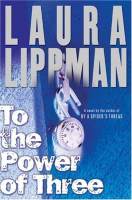



October 2026
"One of the season's most powerful new novels is Laura Lippman's To the Power of Three, a gripping tale that is a mystery only in the same sense as To Kill a Mockingbird was.
This is a brilliant, insightful, moving tale of three girls, best friends forever, whose lives crumble when a shooting at their suburban Baltimore high school leaves one injured, one dead and one dying ...
The troika of teenagers who form the center of the novel are as real, as intriguing and as heartbreaking as any characters you will ever read about in a whodunit. To the Power of Three is the best mystery novel of 2026 so far.
David Montgomery
Chicago Sun-TimesRunning on Empty
[P]erhaps we can think of this kind of reading as a process of unveiling. Before, we were afraid of what we would see, expecting that we would encounter the august patriarch, bearded and implacable, fixing us with his authoritative eye. We girded ourselves like Antigone before Creon. Now we have learned that the face beneath the veil is not the bearded father's, but the pimply boy's. Absorbing in his power to tell a tale. Nevertheless a boy.The 11th book, tentatively known as No Good Deeds, left home Sept. 26th and I feel as aimless and lost as any empty nester. Technically, I have no shortage of things to keep me busy -- Baltimore Noir galleys, a review, an essay, a short story, research for book #12, books for blurbing consideration -- but I admit to surrendering to slacker mode in the last, lovely days of September. In such a mood, I'm more likely to re-read than read, so I put down Zadie Smith's On Beauty, charming as it is, and picked up Rabbit is Rich, the first John Updike novel I ever read and the only one I re-read regularly.--Mary Gordon, "Good Boys and Dead Girls."--
The third Rabbit novel was published the year I graduated from college and it was the first truly contemporaneous adult novel I remember reading. (Children's books were just starting to be self-consciously relevant when I was growing up, but college meant classics. Mr. Sammler's Planet was probably the most chronologically modern novel I read at Northwestern.) Set in 1979, Rabbit is Rich is stuffed with references to things that were still fresh in my mind at first reading -- Skylab, All in the Family, the price of gold and, of course, the gas crisis. Indeed the novel begins:
Running out of gas, Rabbit Angstrom thinks as he stands behind the summer-dusty windows of the Springer Motors display room watching the traffic go by on Route 111, traffic somehow thin and scared compared to what it used to be. The fucking world is running out of gas. . . . . Gas lines at ninety-nine point nine cents, and ninety percent of the stations to be closed for the weekend.It's probably not a coincidence that I picked up Rabbit is Rich after filling my gas tank near Rabbit Country, at a BP station in central Pennsylvania. It cost almost $35 to put 12.5 gallons in the tank of my Passat. And that was a relief after the $50 fill-up a few weeks ago in Potomac, which has bragging rights to some of the highest gas prices in all of the nation. But a quick trip to the Inflation Calculator (an addictive tool for those of us who frequent this site), points up that a dollar in 1979 would be equivalent to $2.83 in 2026, two cents more than the average cost of regular unleaded nationwide as of September 27th.
� John Updike, 1981
Rabbit is Rich is full of numbers, and I'm a sucker for such details whether I'm reading Madame Bovary or Mildred Pierce. There is the going rate for a $60,000 mortgage (a staggering 13 percent); the range of prices at Springer Motors, where a two-door Corona starts at $3,900; the complex calculations as Harry Angstrom switches from gold to silver, advised by a seemingly sage friend that "gold has gone about as far as it can go for now: the little man in America has caught the fever and when the little man climbs on the bandwagon the smart money gets off. Silver, now that's another story: the Hunt brothers down in Texas are buying up silver futures at the rate of millions a day, and big boys like that must know something." To add insult to injury, the buddy who gives Harry this bum tip also ends up sleeping with his wife when a trio of couples decides to swap spouses on a Caribbean vacation, a last gasp of the swinging seventies. I don't think it's incidental that Rabbit is Rich and the 1970s end almost concurrently, with Rabbit contemplating his first grandchild on Super Bowl Sunday: "His. Another nail in his coffin. His."
In re-reading Rabbit is Rich, I wrestle with what F. Scott Fitzgerald once decreed the true test of the first-rate mind -- "the ability to hold two contradictory ideas at the same time." (Please understand that I'm not saying that I have a first-rate mind, just that I show up for the test every now and then.) My affection for Rabbit is Rich has been tempered by Mary Gordon's brilliant essay on Updike, Faulkner and Dreiser, "Good Boys and Dead Girls." The title essay in a terrific book, it examines the way that male protagonists in the Rabbit books, Light in August, and An American Tragedy gain their freedom from the death of females.In seeing Other People as antithetical to heroic fulfillment, many male American writers have locked themselves into an adolescent solipsism that often blames women for the frustration of the boy's solitary dreams . . . How then do we read these dominant storytellers after we have acquired a certain kind of vision? . . . I would be sorry never again to experience Dreiser's vibrant descriptions, or Faulkner's dreamy poetry, whereas it will be no loss for me to contemplate not reading the final installment of the Rabbit tetralogy . . . because Updike's style, with its fake poetic otiosity, provides me with insufficient compensations.No, I didn't know what otiosity meant until I looked it up, but then -- my spellcheck didn't recognize it either. At any rate, I don't read Rabbit is Rich for Updike's voice, so I'm not worried whether the style is fake or otiose. I see Gordon's point: celebrated writers can be as unreliable as their narrators and it's not advisable to absorb their worldview as wisdom from on high. I always keep in mind "that the face beneath the beard is not the bearded father's." Yet this advice ultimately allows me to continue reading some problematic writers, of which crime fiction has no shortage. It's not only literary writers who fall into the trap of seeing "Other People" as antithetical to their heroes' fulfillment -- or mere stepping stones along the hero's path to self-awareness.� Mary Gordon, 1991
The bottom line is that I prefer novels where people have sharply delineated jobs and the author knows what a jar of freeze-dried cashews cost -- $2.89, Harry "Rabbit" Angstrom reflects as he shakes them into a bowl, up 30 cents since the last time he bought them. That's $8.18 in 2026 dollars.No Longer Area-Code Deficient
Back in the day, when every new hire at The (Baltimore) Sun seemed to come from the Philadelphia Inquirer, we used to describe them as area-code enhanced. Well, I finally get a little 215 in my life on Oct. 6th, keeping company with some very fine gentlemen as part of the 215 Festival. Details here. Hope to see you at McGlinchey's and remember: first editions of The Wheelman are extremely collectible. (Scroll down to September 18th.)

